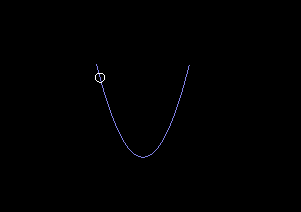I've been trying to write down equations of motion for a bead with mass m on a wire with reduced coordinates. I tried to pick a simple function \(y = x^2\). I chose a generalized coordinate \(q\) to define position along the arc: \(x = (q, q^{2})\). By applying the Euler-Lagrange equation \(\frac{d}{dt}\left(\frac{\partial L}{\partial \dot{q}}\right) - \frac{\partial L}{\partial q} = 0\) I've written down the equation of motion:
$$ \ddot{q} = -\left( \frac{4q\dot{q} + 2Gq}{1 + 4q^2} \right) $$
This equation works well enough with numeric integration:

I wanted to find an analytic solution for \(q\). When looking around at other differential equation solutions it seems like a small angle approximation is often used, but in my case there are no cos or sin functions to approximate. Perhaps there are some kinds of manipulations that would put the equation into a more familiar form that can be solved in terms of sin and cos. Intuitively this looks like a simple harmonic motion of some kind, but I'm not familiar with differential equations enough to move forward...
I'm pretty stuck at this point, would anyone be able to point me in the right direction? Or even worse, maybe this equation cannot be solved analytically (even with small angle approximation) and I just need to choose a different equation to represent the wire!








